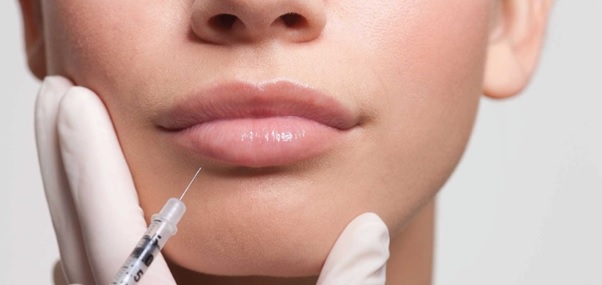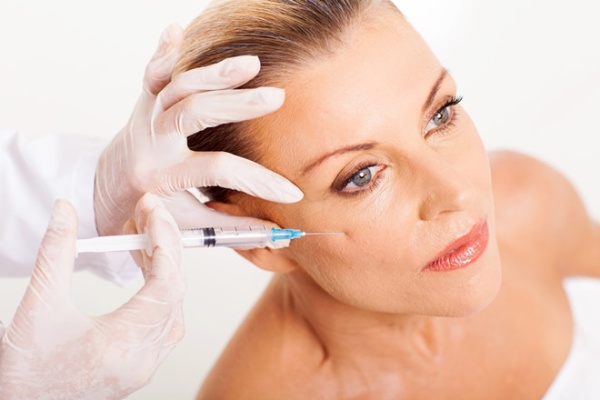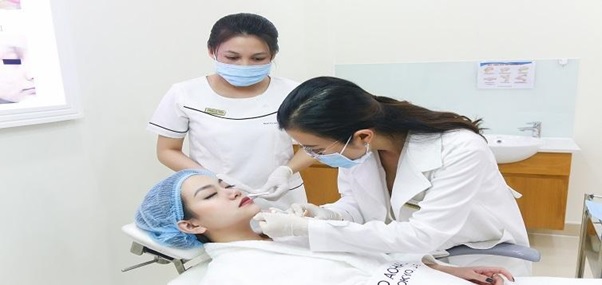- ROHTO AOHAL CLINIC: RECRUITMENT NEWS JANUARY 2024 16.01.2024
- High-end dermatology clinic - aesthetic clinics in Vietnam are highly appreciated 20.12.2023
- ROHTO AOHAL CLINIC CELEBRATES 8TH ANNIVERSARY 26.09.2023
- How safe are Botox injections for the jawline? 28.06.2021
- ROHTO AOHAL CLINIC: RECRUITMENT NEWS FEBRUARY 2024 22.02.2024
EFFECTIVELY WAY OF PIGMENTATION REMOVAL FROM DEEP WITHIN ACCORDING TO EXPERT ADVICE
|
Table of Contents 1. What is skin pigmentation? Factors affecting skin pigmentation 2. Why does skin pigmentation increase? What types are there? 3. How to prevent skin hyperpigmentation
4. Remove pigmentation from deep within like an expert
|
Bright white and even-toned skin is always the wish of women. However, pigmentation disorders can cause the skin to no longer have even color, but black or white spots appear on the skin, causing loss of aesthetics and confidence. So what skin pigmentation diseases include and how to remove diseased pigmentation to preserve youthful skin will be answered in the article below.
1. What is skin pigmentation? Factors affecting skin pigmentation
Pigment is a component that makes up the color of each person's skin, hair, retina and eye mucous membranes. Pigmentation is due to the deposition of melanin produced by Melanocytes (or melanocytes). Most people have about the same amount of melanocytes.
The difference in skin color of people on continents is due to the amount of melanin produced and is not affected by sunlight. This is also the independence of skin pigmentation. Besides, the color of the skin also depends on melanin pigments, which provide a natural protective barrier for the skin, against the effects of UV ultraviolet rays. Melanin pigment is divided into 2 types:
- Eumelanin (brown and black melanin): This type of melanin pigment is the best known. It is usually black or dark brown in color, found in people with brown or black skin. This melanin pigment helps protect the skin against UV rays.
- Pheomelanin (red melanin): This type of pigment is also known as red melanin. It often appears in people with white skin or red hair. This type of melanin does not protect against UV rays. The synthesis of this type of pigment also creates free radicals that attack the skin.
The above two types of melanin pigments are present in everyone. However, for each individual, the ratio of each type of melanin is different. The amount of these two pigments will determine the natural skin color, as well as the degree of tanning of the skin when exposed to direct sunlight.
Ultraviolet rays in sunlight stimulate melanin production, as well as a number of other factors that cause skin aging. Other factors hinder melanin production.
Pigment diseases commonly include conditions such as:
- Hyperpigmentation: Melasma, dark spots, freckles, age spots,...
- Depigmentation, loss of pigmentation: Vitiligo, vitiligo, tinea versicolor, leprosy, psoriasis, atopic dermatitis,...
2. Why does skin pigmentation increase? What types are there?
The condition of the skin becoming dark and black patches appearing is called hyperpigmentation. Pigmented patches can be small or cover large areas of skin on the face, trunk, arms, legs, or entire body. Hyperpigmentation is usually harmless, but it can be a symptom of another medical condition.
Some common forms of hyperpigmentation include:
- Dark skin
Darkening of the skin is a form of skin hyperpigmentation caused by the effects of sunlight. Melanocytes specialize in producing melanin (hyperpigmentation) which causes the skin to darken when exposed to sunlight for a long time. Skin darkening often appears as spots and small dark patches of skin appearing on areas of skin directly exposed to sunlight such as the face, hands or other exposed areas of the body.
- Melasma
Melasma is similar to dark skin, however the dark skin areas caused by melasma are often larger in size. Melasma often appears due to hormonal changes, such as during pregnancy because the body overproduces melanin, causing melasma. Or using birth control pills can also cause melasma because of hormonal changes similar to pregnancy. Areas susceptible to melasma due to increased melanin pigmentation are the face, abdomen, or any area of the body.
- Freckles, age spots
Freckles and age spots are small brown spots that commonly appear on the face and arms. Freckles, age spots and other hyperpigmented skin patches may darken, or become more pronounced, when the skin is exposed to direct sunlight. This happens because melanin absorbs the energy of harmful ultraviolet rays from the sun to protect the skin from overexposure. The result of this process is hyperpigmentation and the appearance of dark brown spots.
In some people with fair skin, melanocytes produce more melanin than others to protect against ultraviolet rays from sunlight. Freckles appear due to this uneven melanin production and are often hereditary.
- Other forms of hyperpigmentation:
Dark acne: Acne leaves dark spots due to damaged skin.
Melasma: Due to injuries including surgery, burns, and lupus.
Photochemical contact dermatitis: Sensitive skin when exposed to lemon and celery.
Acanthosis nigricans disorder: Thickened and darker skin in the armpits and back of the neck, or people with diabetes.
Skin darkening: Due to aging, a sign of cancer.
Increased melanocytes lentigines cause oval brown spots: Peutz-Jeghers syndrome is characterized by many melanocytes in the lips and polyps in the stomach and intestines; Xeroderma pigmentosum syndrome and polylentigine syndrome (Leopard syndrome)
Some other causes of skin hyperpigmentation: Abnormal skin growth, dermatitis, skin trauma, medical diseases, drugs, chemicals, heavy metals.
3. How to prevent skin hyperpigmentation
3.1. Use care cosmetics to prevent hyperpigmentation
According to the American Academy of Dermatology (AAD), ingredients that help remove melanin can be used in OTC (over-the-counter) products such as: Azelaic and glycolic acids, vitamin C and retinoids. Cosmetics and medications containing ingredients such as vitamin C, licorice root and kojic acid also help reduce hyperpigmentation by inhibiting tyrosinase, an enzyme that causes melanin formation to darken the skin.
Although many OTC products claim to "bleach" dark spots, the AAD specifically warns against applying liquid bleach to the skin and to be wary of commercial skin-lightening products that may be contaminated with mercury. , steroids and other harmful ingredients.
3.2. Keeps skin moisturized
Skin moisturizing products contain glycerin, hyaluronic acid, retinol... to help enhance skin cell regeneration. These ingredients also help bleaches work more effectively.
3.3. Protect skin from sunlight
The most effective way to prevent hyperpigmentation caused by the sun is to regularly apply sunscreen with a sun protection factor (SPF) of 30++ or higher every day about 30 minutes before going outdoors, including on cloudy or cool days, and reapply every 2 hours.
In addition, the AAD also recommends avoiding going outdoors between 10 a.m. and 2 p.m., because UV rays from the sun are strongest at this time. You should wear a wide-brimmed hat to protect your face, ears and neck, wear long clothes that cover your arms and legs, and wear sunscreen.
3.4. Avoid damaging the skin
Do not scratch or squeeze pimples, as this will increase inflammation and aggravate hyperpigmentation.
3.5. Supplement foods that help prevent hyperpigmentation
- Rich in antioxidants: Fruits, vegetables, cashew nuts, chestnuts,... contain a lot of vitamins C, E, selenium, beta-carotene, lycopene,... which prevent the formation and development of harmful substances. skin pigmentation.
- Drink 1.5 - 2 liters of water to eliminate toxins.
- Increase Omega-3: Fish such as salmon, mackerel, mackerel, flax seeds, chia seeds...
- Increase vitamin A: Eggs, milk, liver, vegetables such as pumpkin, carrots, spinach, spinach,...
- Various colorful vegetables: Tomatoes, eggplants, cucumbers, watermelons, strawberries, apples,...
4. Remove pigmentation from deep within like an expert
4.1. Use skin whitening pills to remove pigmentation
Glutathione (GSH) is the most common ingredient in skin whitening pills. This active ingredient is used alone or in combination with other active ingredients. Glutathione is an antioxidant synthesized in mammalian cells from three amino acids: glutamate, cysteine and glycine. It is also available in nature like watermelon, avocado, tomatoes, broccoli, spinach.
Glutathione's skin whitening mechanism is: acting on the melanin transport process of TYRs, inhibiting TYRs directly by neutralizing and converting eumelanins that cause skin darkening into pheomelanins that lighten the skin, eliminating melanin pigments. Free radicals cause melanin proliferation, regulating the skin whitening ability of substances that are toxic to melanocyte cells.
4.2. BBL light therapy
BBL pulsed light is a world-famous hyperpigmentation treatment technology developed by Sciton company (USA) and has been certified by the FDA for safety and effectiveness. BBL broad-spectrum pulsed light technology mainly affects the epidermis (top layer) of the skin, gently breaking down pigment molecules that cause dark spots into extremely small molecules. Finally, these pigments are eliminated according to the human body's natural purification mechanism.
BBL pulsed light therapy is extremely safe and maintains comfort throughout the treatment process thanks to superior cooling technology. BBL light wavelength accurately impacts the skin area that needs treatment, ensuring outstanding effectiveness and not causing damage to other skin areas.
BBL treatment is spaced every 2 - 4 weeks for enough time to be safe for the skin and for the most effective treatment. ROHTO AOHAL CLINIC is a pioneer in successfully applying BBL pulsed light technology in the treatment of melasma in Vietnam and has been awarded the title of "Vietnam's leading melasma treatment unit".
4.3.Laser Q-Switched
Q-Switched laser is the top choice in treating forms of skin hyperpigmentation such as dark spots, melasma, freckles, age spots...ROHTO AOHAL CLINIC applies Q-Switched Laser technology developed by two famous brands. The leaders in the cosmetic treatment industry are Medlite and Lutronic. The Q-Switched lasers of both brands are FDA approved for skin safety.
Q-Switched Laser technology possesses a wavelength of 562 nm that directly impacts the epidermis of the skin. Laser rays gently break down pigment molecules that cause dark spots deep in the skin's epidermis into extremely small supermolecules and eliminate them from the body according to the natural purification mechanism. In addition to removing pigmentation that causes skin darkening, Q-Switched Laser also has the ability to stimulate the growth of collagen and elastin to help skin become smoother, more evenly colored and more youthful.
Q-Switched Laser hyperpigmentation treatment at ROHTO AOHAL CLINIC is spaced every 4 - 5 weeks to ensure safety and effectiveness.
4.4. Sylfirm - Phi Kim Radio
In addition, there are treatments for hyperpigmentation and skin redness using technologySylfirm - radio frequency nonmetals. With frequency energy from the non-metallic tipSylfirm 2mHz goes deep below the skin to 3.5mm, the needle body emits radio waves in the skin accurately within 0.32 seconds. This helps repair damaged skin cells and blood vessels, restore the basement membrane, and prevent melanocytes from going deeper under the skin, causing melasma to spread and be difficult to treat.Sylfirm It also has the ability to selectively treat damaged skin cells without affecting healthy skin cells. From there, the skin pigmentation will be completely treated and will no longer be able to return.
4.5. PRF - Platelet Rich Fibrin
PRF is a blood extraction technology that produces cells (platelets, red blood cells, white blood cells) and growth factors in the form of fibrin membranes from the customer's blood. Then injected back into the skin to treat hyperpigmentation. Platelet cells are held in a fibrin mesh framework, which when activated, dissociates alpha granules and releases growth factors. These factors help to effectively regenerate the skin and treat dark spots, freckles, and uneven skin tone with fewer skin reactions.
Above are painless and effective methods of removing skin pigmentation that are being widely applied. For more detailed advice and examination of your skin condition, contact ROHTO AOHAL CLINIC today.
ROHTO AOHAL CLINIC - CONTACT INFORMATION
1st location: 02 Pham Dinh Toai, Vo Thi Sau ward, District 3, Ho Chi Minh City
☎ Phone: (028) 3930 9555
2nd location: 207/4 Nguyen Van Thu, Da Kao Ward, District 1, Ho Chi Minh City
☎ Phone: (028) 3827 9737
3rd location: 136 Trieu Viet Vuong, Nguyen Du Ward, Hai Ba Trung District, Ha Noi City
☎ Phone: (024) 3375 5588







